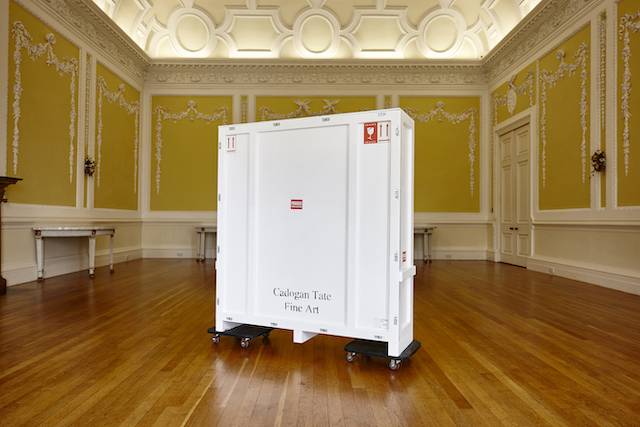Disclosure Sponsored Links: This post contains a paid-for sponsored link, meaning we have received compensation in exchange for including it. Sponsorship does not influence our content, but we believe in transparency regarding paid placements.
- Climate-controlled storage maintains stable temperature and humidity levels, preserving the integrity and value of fine art.
- Key benefits include the prevention of environmental damage, enhanced security measures, and the protection of materials and colors.
- When choosing a facility, consider strict climate controls, convenient location, accessibility, and positive reviews from other art collectors.
- Proper preparation involves using high-quality packing materials, documenting and inventorying art pieces, and clearly communicating specific needs to the storage provider.

Proper storage is crucial for preserving the value and beauty of your art collection. Protecting your art from environmental damage is paramount whether you’re an artist, a collector, or a gallery owner. This is where climate-controlled storage comes into play. By maintaining optimal conditions, these specialised storage units ensure that your fine art remains in pristine condition for years to come. In this blog, we’ll explore expert tips on using climate-controlled storage for fine art, highlighting the key benefits and considerations for keeping your treasured pieces safe.
Table of Contents
Understanding Climate-Controlled Storage
Climate-controlled storage units are designed to maintain stable temperature and humidity levels, which are crucial for preserving fine art. Fluctuations in temperature and humidity can cause severe damage to artwork, including warping, cracking, fading, and mould growth.
Temperature control typically involves keeping the storage environment within a range of 65-75°F (18-24°C), which helps prevent thermal expansion and contraction that can damage the structural integrity of art pieces. Humidity control is equally important; maintaining relative humidity levels between 40-50% helps protect against moisture-related issues.
Artworks are made from a variety of materials—canvas, paper, wood, metal, and textiles—all of which can be sensitive to environmental changes. By using climate-controlled storage, you can ensure these materials remain stable, preserving the integrity and value of your collection.
Benefits of Climate-Controlled Storage for Fine Art
Climate-controlled storage offers numerous benefits for preserving fine art. One of the primary advantages is the preservation of materials and colours. By maintaining stable temperature and humidity levels, these units prevent the deterioration that can occur with environmental fluctuations. This means your art’s colours remain vibrant, and the materials retain their original texture and strength.
Additionally, climate-controlled storage protects your art from environmental damage such as mould, mildew, and pests. Standard storage units can expose your art to these harmful elements, which can cause irreversible damage. The controlled environment of a climate-controlled unit ensures that your art is safe from such risks.
Enhanced security measures are another significant benefit. Climate-controlled storage facilities often have advanced security systems, including a commercial security camera system, alarm systems, and restricted access. This ensures that your valuable collection is not only protected from environmental factors but also from theft and vandalism.
Choosing the Right Climate-Controlled Storage Facility
When selecting a climate-controlled storage facility for your fine art, there are several key features to consider. First, ensure the facility maintains strict temperature and humidity controls. Ask about their monitoring systems and how frequently they check and adjust the environment.
Location and accessibility are also important. Choose a facility that is conveniently located and offers easy access for both you and your fine art movers. This will make it simpler to transport your art to and from storage and to check on your collection as needed.
Reputable facilities should have a proven track record of successfully storing fine art. Look for reviews and testimonials from other artists, collectors, or galleries who have used their services. Recommendations from trusted sources can help you make an informed decision.
Preparing Your Art for Storage
Proper preparation is crucial when storing fine art. Start by using high-quality packing materials. Acid-free tissue paper, bubble wrap, and custom crates are essential for protecting your pieces during transit and storage. Each type of artwork may require different packing techniques, so it’s important to tailor your approach to each piece.
Documentation and inventory are also vital. Create a detailed inventory list, complete with photographs and descriptions of each item. This will help you keep track of your collection and provide essential information for insurance purposes.
Communicate any specific needs to the storage provider. If certain pieces require particular handling or conditions, make sure the facility is aware and capable of accommodating these requirements. Clear communication ensures that your art receives the care it needs.
Working with Fine Art Movers
Art movers are crucial in transporting your artwork to a climate-controlled storage facility. These professionals have the expertise and equipment to handle delicate and valuable pieces safely. They use specialised techniques and materials to protect your art during the move.
When working with art logistics companies, it’s essential to ensure they understand the specifics of your collection. Provide them with detailed instructions and any special handling requirements. Coordination between the movers and the storage facility is essential for a smooth transition. Choose a fine art mover like Cagodan Tate, who appreciates the importance, value, and vulnerabilities of the pieces you are transporting. Partnering with the best movers London can provide guarantees that your artwork is handled with the utmost care during transit, ensuring it arrives at the climate-controlled storage facility without a hitch.
Additionally, ask the movers about their insurance coverage and what it entails. Knowing that your art is protected during transit will give you peace of mind.
Conclusion
Climate-controlled storage is essential for preserving the integrity and value of your fine art collection. By maintaining stable temperature and humidity levels, these units protect your artwork from environmental damage and deterioration. Choosing the right storage facility, preparing your art properly, and working with experienced fine art movers are all crucial steps in ensuring your pieces remain in pristine condition.
Remember, the effort you put into protecting your art today will pay off in the long run, ensuring your collection continues to bring joy and value for years.








